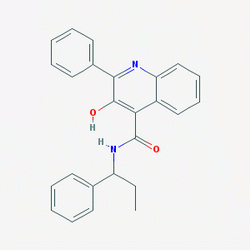| Cas No.: | 174636-32-9 |
| Chemical Name: | 3-hydroxy-2-phenyl-N-(1-phenylpropyl)quinoline-4-carboxamide |
| Synonyms: | SB-223412; SB223412; SB 223412 |
| SMILES: | O=C(C1=C(O)C(C2=CC=CC=C2)=NC3=CC=CC=C13)N[C@H](C4=CC=CC=C4)CC |
| Formula: | C25H22N2O2 |
| M.Wt: | 382.45438 |
| Purity: | >98% |
| Sotrage: | 2 years -20°C Powder, 2 weeks 4°C in DMSO, 6 months -80°C in DMSO |
| Description: | Talnetant (SB 223412) is a potent and selective NK3 receptor antagonist (ki=1.4 nM, hNK-3-CHO); 100-fold selective for the hNK-3 versus hNK-2 receptor, with no affinity for the hNK-1 at concentrations up to 100 uM. |
| Target: | IC50 Value: 1.4 nM (hNK-3-CHO binding Ki) [1]Target: NK3 receptor |
| In Vivo: | Rectal barostat tests were performed on 102 healthy volunteers, randomized to receive either oral talnetant 25 or 100 mg or placebo over 14-17 days [2]. Talnetant (3-30 mg/kg i.p.) significantly attenuated senktide-induced 'wet dog shake' behaviors in the guinea pig in a dose-dependent manner. Microdialysis studies demonstrated that acute administration of talnetant (30 mg/kg i.p.) produced significant increases in extracellular dopamine and norepinephrine in the medial prefrontal cortex and attenuated haloperidol-induced increases in nucleus accumbens dopamine levels in the freely moving guinea pigs [3].Toxicity: Talnetant had no effect on rectal compliance, sensory thresholds or intensity ratings compared with placebo [2].Clinical trial: Study Of Talnetant Versus Placebo And Risperidone In Schizophrenia. Phase 2 |
| In Vitro: | n vitro studies demonstrated that 53 is a potent functional antagonist of the hNK-3 receptor (reversal of senktide-induced contractions in rabbit isolated iris sphincter muscles and reversal of NKB-induced Ca2+ mobilization in CHO cells stably expressing the hNK-3 receptor), while in vivo this compound showed oral and intravenous activity in NK-3 receptor-driven models (senktide-induced behavioral responses in mice and senktide-induced miosis in rabbits) [1]. Talnetant has high affinity for recombinant human NK3 receptors (pKi 8.7) and demonstrates selectivity over other neurokinin receptors (pKi NK2 = 6.6 and NK1<4). In native tissue-binding studies, talnetant displayed high affinity for the guinea pig NK3 receptor (pKi 8.5) [3]. |
| References: | [1]. Giardina GA, et al. Discovery of a novel class of selective non-peptide antagonists for the human neurokinin-3 receptor. 2. Identification of (S)-N-(1-phenylpropyl)-3-hydroxy-2-phenylquinoline-4-carboxamide (SB 223412). J Med Chem. 1999 Mar 25;42(6):1053- [2]. Houghton LA, et al. Effect of the NK(3) receptor antagonist, talnetant, on rectal sensory function and compliance in healthy humans. Neurogastroenterol Motil. 2007 Sep;19(9):732-43. [3]. Dawson LA, et al. In vitro and in vivo characterization of the non-peptide NK3 receptor antagonist SB-223412 (talnetant): potential therapeutic utility in the treatment of schizophrenia. Neuropsychopharmacology. 2008 Jun;33(7):1642-52. |

 To enhance service speed and avoid tariff delays, we've opened a US warehouse. All US orders ship directly from our US facility.
To enhance service speed and avoid tariff delays, we've opened a US warehouse. All US orders ship directly from our US facility.




















